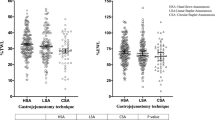Abstract
Background
Different gastrojejunal anastomotic (GJA) techniques have been described in laparoscopic Roux-en-Y gastric bypass (LRYGB). There is conflicting data on whether one technique is superior to the other. We aimed to compare hand-sewn (HSA), circular-stapled (CSA) and linear-stapled (LSA) anastomotic techniques in terms of stricture rates and their impact on subsequent weight loss.
Methods
A prospectively collected database was used to identify patients undergoing LRYGB surgery between March 2005 and May 2012. Anastomotic technique (HSA, CSA, LSA) was performed according to individual surgeon preference. The database recorded patient demographics, relevant comorbidities and the type of GJA performed. Serial weight measurements and percentage excess weight loss (%EWL) were available at defined follow-up intervals.
Results
Included in the data were 426 patients, divided between HSA (n = 174, 40.8 %), CSA (n = 110, 25.8 %) and LSA (n = 142, 33.3 %). There was no significant difference in the stricture rates (HSA n = 17, 9.72 %; CSA n = 9, 8.18 %; LSA n = 8, 5.63 %; p = 0.4006). Weight loss was similar between the three techniques (HSA, CSA and LSA) at 3 months (40.6 % ± 16.2 % vs 35.92 % ± 21.42 % vs 48.21 % ± 14.79 %; p = 0.0821), 6 months (61.48 % ± 23.94 % vs 58.16 % ± 27.31 % vs 60.18 % ± 22.26 %; p = 0.2296), 12 months (72.94 % ± 19.93 % vs 69.72 ± 21.42 % vs 66.05 % ± 17.75 %; p = 0.0617) and 24 months (73.29 % ± 22.31 % vs 68.75 % ± 24.71 % vs 69.40 % ± 23.10 %; p = 0.7242), respectively.
The stricture group lost significantly greater weight (%EWL) within the first 3 months compared to the non-stricture group (45.39 % ± 16.82 % vs 39.22 % ± 21.93 %; p = 0.0340); however, this difference had resolved at 6 months (61.29 % ± 18.50 % vs 59.79 % ± 23.03 %; p = 0.8802) and 12 months (71.59 % ± 18.67 % vs 68.69 % ± 22.19 %; p = 0.5970).
Conclusions
There was no significant difference in the rate of strictures between the three techniques, although the linear technique appears to have the lowest requirement for post-operative dilatation. The re-intervention rate will, in part, be dictated by the threshold for endoscopy, which will vary between units. Weight loss was similar between the three anastomotic techniques. Surgeons should use techniques that they are most familiar with, as stricture and weight loss rates are not significantly different.
Similar content being viewed by others
References
Mokdad AH, Bowman BA, Ford EA, et al. The continuing epidemics of obesity and diabetes in the United States. JAMA. 2001;286(10):1195–200.
Obesity and overweight fact sheet. World Health Organisation. 2012 [Online] Available at: http://www.who.int/mediacentre/factsheets/fs311 Accessed 16 Jul 2012.
Ford ES, Giles WH, Dietz WH. Prevalence of the metabolic syndrome among US adults. JAMA. 2002;287(3):356–9.
Peeters A, Barendregt JJ, Willekens F, et al. Obesity in adulthood and its consequences for life expectancy: a life-table analysis. Ann Intern Med. 2003;138:24–32.
Sjostrom L, Lindroos AK, Peltonen M, et al. Swedish obese subjects study scientific group. Lifestyle, diabetes, and cardiovascular risk factors 10 years after bariatric surgery. NEJM. 2004;351(26):2683–93.
Bendewald FP et al. Comparison of hand-sewn, linear-stapled, and circular-stapled gastrojejunostomy in laparoscopic Roux-en-Y gastric bypass. Obes Surg. 2011;21(11):1671–5.
Gonzalez R, Lin E, Venkatesh K, et al. Gastrojejunostomy during laparoscopic gastric bypass: analysis of 3 techniques. Arch Surg. 2003;138:181–4.
Abdel-Galil E, Sabry AA. Laparoscopic Roux-en-Y gastric bypass—evaluation of three different techniques. Obes Surg. 2002;12(5):639–42.
Jarry J, Wagner T, de Pommerol M, et al. Laparoscopic Roux-en-Y gastric bypass: comparison between hand-sewn and mechanical gastrojejunostomy. Updates Surg. 2012;64(1):25–30.
Giordano S, Salminen P, Biancari F, et al. Linear stapler technique may be safer than circular in gastrojejunal anastomosis for laparoscopic Roux-en-Y gastric bypass: a meta-analysis of comparative studies. Obes Surg. 2011;21(12):1958–64.
Abu Dayyeh BK, Lautz DB, Thompson CC. Gastrojejunal stoma diameter predicts weight regain after Roux-en-Y gastric bypass. Clin Gastroenterol Hepatol. 2011;9(3):228–33.
Filho AJ, Kondo W, Nassif LS, et al. Gastrogastric fistula: a possible complication of Roux-en-Y gastric bypass. JSLS. 2006;10(3):326–31.
Madan AK, Harper JL, Tichansky DS. Techniques of laparoscopic gastric bypass: on-line survey of American Society of Bariatric Surgery practicing surgeons. Surg Obes Relat Dis. 2008;4:166–73.
Fisher BL, Atkinson JD, Cottam D. Incidence of gastroenterostomy stenosis in laparascopic Roux-en-Y gastric bypass using 21-or 25-mm circular stapler: a randomized prospective blinded study. Surg Obes Relat Dis. 2007;3(2):176–9.
Bodhjalian A, Lnager FB, Kranner A, et al. Circular- vs. linear-stapled gastrojejunostomy in laparoscopic Roux-en-Y gastric bypass. Obes Surg. 2010;20:440–6.
Sources of Funding
Department of Surgery, Chelsea and Westminster Hospital NHS Trust
Conflict of Interest
None of the authors have a potential conflict of interest.
Author information
Authors and Affiliations
Corresponding author
Rights and permissions
About this article
Cite this article
Lee, S., Davies, A.R., Bahal, S. et al. Comparison of Gastrojejunal Anastomosis Techniques in Laparoscopic Roux-en-Y Gastric Bypass: Gastrojejunal Stricture Rate and Effect on Subsequent Weight Loss. OBES SURG 24, 1425–1429 (2014). https://doi.org/10.1007/s11695-014-1219-9
Published:
Issue Date:
DOI: https://doi.org/10.1007/s11695-014-1219-9




